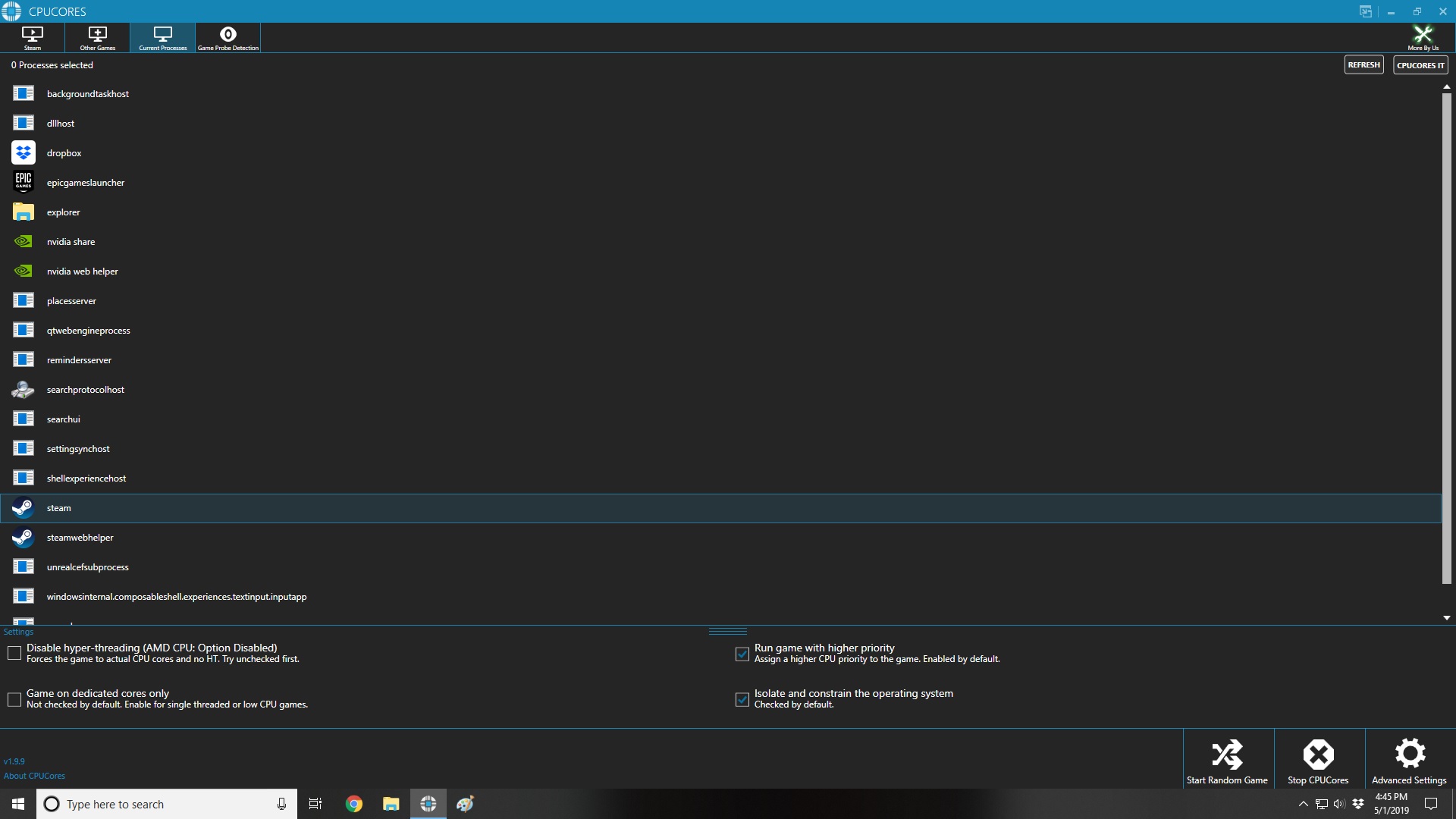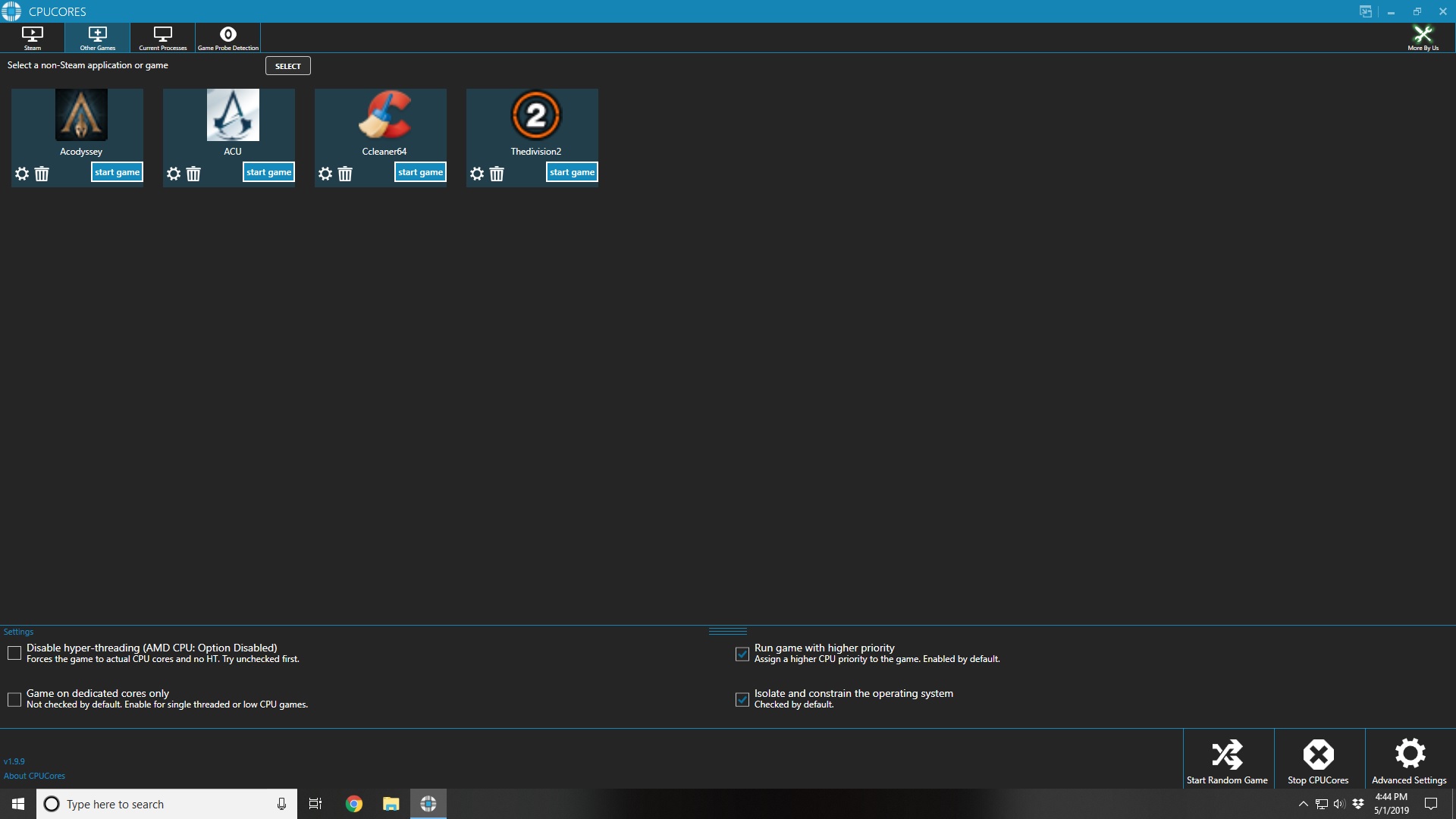

For some PC gamers, there’s nothing greater than the satisfaction of knowing that everything is running at optimum capacity. Seeing the FPS (frames per second) meter climb up and never waver, hearing the soft hum of case and GPU fans, watching the on-screen action flow with zero latency, yep, that’s the good stuff. It’s nice when things work as they should, it’s even better when they exceed all expectations.
CPUCores, a new software program available on Steam from developer Tim Sullivan, aims to capitalize on that idea of harmonious efficiency. According to its Steam page and other marketing materials, CPUCores can directly interface with both your operating system and your Steam library to increase game performance and ensure your games are getting all the resources they need. Having tested the software for myself, I’ve come away impressed with CPUCores’ ease of use, but I’m not entirely convinced it does enough to justify its asking price.
Seamless integration with Steam

One of CPUCores’ big selling points is how it effortlessly layers itself onto your existing Steam setup. When you first load up CPUCores, it auto-detects all of your installed Steam games and adds them to a dedicated UI tab, complete with graphics, individual configuration settings, and dedicated start buttons. A separate “Other Games” tab also allows you to add non-Steam games and even any non-gaming programs you feel might benefit from additional CPU resources (like Adobe Photoshop).
Yet another UI tab lists all of your PC’s currently running processes, letting you see at-a-glance if there’s anything running in the background that might be interfering with game performance. A final “Game Probe” tab allows you to configure specific games so that CPUCores auto-engages when you launch that game, even if you didn’t launch it through the CPUCores interface.
As for how CPUCores affects the games themselves, it does so through four different toggleable settings:
- Enabling/disabling hyper-threading – If you’re using an Intel CPU, this option allows you to enable or disable hyper-threading on a game-by-game basis to see if it improves performance
- Game on Dedicated Cores Only – This option assigns dedicated CPU cores to a given game while it’s running. Not every game benefits from this which is why it’s toggled off by default.
- Run Game with Higher Priority – As its name suggests, this option (which is enabled by default) gives a running game a higher process priority, theoretically boosting performance in the process.
- Isolate and Constrain The Operating System – Another option that’s enabled by default, this switch “constrains” any non-gaming applications on your operating system, again theoretically boosting your game’s performance as a result.
Along with dedicated start buttons for each game, CPUCores also includes a “Start Random Game” option which picks an installed Steam game at random and boots it up. This leads me to surmise that Tim Sullivan wants CPUCores to function as both a performance-testing tool and a performance-enhancing utility. Unfortunately, the limits of CPUCores’ functionality and visual feedback currently hold back its testing potential.
Unclear performance benefits

CPUCores doesn’t come with any sort of in-game visuals or overlay to show how the game is performing (and supposedly benefiting from the software’s enhancements). This means that all the user has to go off of are their own observations and any additional testing resources they have available.
If you visit CPUCores’ Steam page, you’ll find a healthy amount of positive reviews, so much so that the software’s overall Steam rating is a solid ‘Mostly Positive’ with over 8,000 reviews posted. Judging from the reviews I read through, it seems CPUCores is the most beneficial to those who have lower-end CPUs. If you’re already working with high-end parts, CPUCores likely won’t do much for you.
I personally saw virtually no difference in how my games performed both with and without CPUCores supporting them. I ran benchmarks for Steam games like Warhammer: Vermintide 2, Tekken 7, and the MMO Neverwinter, along with non-Steam games I added through the Uplay launcher like The Division 2, Assassin’s Creed Odyssey, and Assassin’s Creed Unity. In every single case the benchmarks came in about the same whether CPUCores was enabled or not.
Something else that’s worth noting is that CPUCores isn’t even required to run some of the functionality it boasts in its marketing. Finding a list of running processes is as simple as hitting ctrl+alt+delete and selecting Task Manager, hyper-threading can be enabled/disabled in your PC’s BIOS, and games can be assigned higher priorities in the Task Manager. What CPUCores is offering, then, is slightly more user-friendly access to these existing features.
Best for lower-end CPUs and casual PC gamers

CPUCores also comes with three optional paid DLC add-ons which, again, are just repackaged versions of inherent PC functionality. The ClearMe add-on claims to clear out unoptimized RAM, but simply rebooting your PC accomplishes the same task. Network Monitor offers network performance and quality statistics, something you can also find by using the netstat command prompt function. System Monitor provides the same information you could find by typing “system information” into your desktop’s search bar.
I appreciate that Tim Sullivan is trying to make such functionality and information easier to access for casual users, but charging money for the privilege feels a little shady, especially since CPUCores already costs $15 on its own. More casual PC gamers (which I’m gathering are CPUCores’ main market) would be better off doing a few Google searches if they’re interested in their PC’s gaming and non-gaming performance metrics.
I won’t go so far as to say CPUCores is an entirely worthless program (since obviously over 8,000 Steam users would disagree with me). However, it’s hard to ignore the feeling that the program is trying to capitalize on more casual PC gamers’ lack of knowledge. Yes, CPUCores is providing a real service, but it’s a service which really only benefits low-end users, and even then only by tweaking parameters which, in most cases, they could just tweak themselves if told how to.
Disclaimer: A review copy of CPUCores was provided to me upon request for the writing of this article.
